ChatGPT said: Steps emulsifiers help with luxury cosmetic formulations
Wiki Article
The Crucial Advantages of Emulsifiers for Smooth and Steady Combinations
Emulsifiers are vital in producing secure and smooth mixes throughout numerous industries. They lower surface stress between immiscible fluids, bring about improved structure and total sensory experiences. In food and cosmetics, their duty prolongs beyond mere blending; they likewise boost service life and item honesty. Comprehending the types and applications of emulsifiers discloses their significance in formulation processes. The nuances of their efficiency warrant further exploration.Recognizing Emulsifiers: The Science Behind the Blend
Emulsifiers are usually overlooked in day-to-day food preparation and food manufacturing, they play a vital duty in maintaining blends that would certainly or else divide. Emulsifiers are substances that lower surface area stress in between 2 immiscible liquids, such as oil and water. They have both hydrophilic (water-attracting) and hydrophobic (water-repelling) properties, allowing them to interact with both stages. This special characteristic enables emulsifiers to create a steady interface, stopping the separation of fats and fluids.Common instances of emulsifiers consist of lecithin, commonly stemmed from eggs or soybeans, and mono- and diglycerides. These substances develop a consistent structure in products like mayo, salad dressings, and sauces. The scientific research behind emulsifiers depends on their capability to produce a secure emulsion, which is important for accomplishing preferable food quality and service life. Comprehending the function of emulsifiers is important for food researchers and cooking specialists intending for regular outcomes.
Culinary Applications: Enhancing Taste and Texture
Emulsifiers greatly enhance culinary applications by enhancing both taste and structure in a variety of food (emulsifiers). They play a necessary duty in creating stable emulsions, which are essential for sauces, dressings, and mayonnaise. By making it possible for the even distribution of fats and water, emulsifiers assure that tastes are unified and well-blended, boosting the general taste experienceIn baked products, emulsifiers contribute to a better crumb framework and boosted moisture retention, leading to products that are soft and attractive. Furthermore, they assist expand rack life by stopping separation and maintaining freshness.
In dairy products, emulsifiers help in producing smooth textures, essential for products like ice lotion and cream cheese, where mouthfeel substantially influences consumer pleasure. Overall, the use of emulsifiers in cooking applications not just elevates taste profiles but also enhances the sensory experience of different food products, making them more enticing and pleasurable.

Aesthetic Utilizes: Creating Lavish Solutions
When developing aesthetic items, the inclusion of emulsifiers is necessary for attaining smooth and luxurious structures. These agents help with the blending of water and oil phases, creating secure solutions that boost item efficiency and user experience. Emulsifiers not just boost the uniformity of lotions and lotions but likewise contribute to the total sensory qualities, enabling a more enjoyable application and really feel on the skin.In addition, emulsifiers play a vital role in the efficient distribution of energetic ingredients, making certain that they stay uniformly distributed throughout the formula. This consistent circulation improves the item's effectiveness, giving targeted advantages such as hydration, anti-aging, and defense. Additionally, the appropriate emulsifier can pass on a wanted thickness, protecting against splitting up and preserving product integrity over time. Ultimately, emulsifiers are important in establishing top quality cosmetic formulas that meet consumer assumptions for luxury and efficiency.
Kinds of Emulsifiers: Natural vs. Synthetic
Understanding the distinctions in between natural and synthetic emulsifiers is crucial for formulators intending to optimize cosmetic items. Natural emulsifiers, stemmed from plant or pet resources, consist of active ingredients like lecithin, beeswax, and different gums. They are frequently favored for their skin-friendly residential properties and biodegradability. Furthermore, they can enhance the sensory profile of solutions, offering a more enticing structure and really feel.On the other hand, synthetic emulsifiers are chemically crafted to develop certain functionalities and stability. Common instances include polysorbates and stearic acid. These emulsifiers generally supply premium efficiency regarding emulsification efficiency and shelf-life stability. However, they might raise worries regarding skin sensitivity and environmental impact.
Ultimately, the option between all-natural and synthetic emulsifiers relies on the preferred item characteristics, formula goals, and consumer choices, highlighting the relevance of comprehending their distinct buildings. emulsifiers.
The Duty of Emulsifiers in Food Conservation

Tips for Making Use Of Emulsifiers Properly in Recipes and Products
When making use of emulsifiers in items and recipes, choosing the suitable kind is important for attaining desired results. In addition, utilizing correct mixing strategies can substantially enhance the security of emulsified combinations. Finally, understanding storage approaches and life span guarantees the longevity and efficiency of these emulsifiers.Choosing the Right Emulsifier

Choosing the appropriate emulsifier can significantly boost the appearance and security of a blend, as the right option relies on the details active ingredients and wanted result. Numerous elements affect this decision, including the sort of oils or fats, the presence of water, and the target consistency. As an example, lecithin is perfect for sauces and dressings, while xanthan gum tissue functions well in gluten-free baking. Furthermore, the emulsifier's compatibility with various other active ingredients plays a substantial duty in accomplishing the preferred security. It is vital to take right into account the temperature level array of the application, as some emulsifiers carry out better under specific problems. Inevitably, recognizing the characteristics of each emulsifier will result in a lot more reliable formulation in products and recipes.
Correct Mixing Methods
Making use of reliable blending methods is important for attaining suitable emulsification in items and dishes. It is essential to introduce emulsifiers progressively, permitting them to disperse uniformly throughout the mixture. High-shear blending methods, such as using a blender or food processor or an immersion mixer, can enhance emulsifier efficiency by breaking down fat globules. Preserving a constant temperature level throughout blending also aids in accomplishing a steady emulsion, as liquids see this site and fats can blend better when warmed. In addition, including components in the appropriate order-- beginning with the liquid stage adhered to by the fat phase-- ensures even circulation. Ultimately, mixing should continue until the desired consistency is gotten to, preventing over-mixing, which can lead to splitting up. Appropriate techniques eventually lead to smoother, a lot more secure emulsions.Storage Space and Rack Life
Although the effectiveness of emulsifiers can greatly boost the top quality of mixes, appropriate storage and interest to rack life are necessary for keeping their performance. Emulsifiers should be kept in a trendy, dry setting, away from direct sunshine and dampness, which can weaken their properties. It is advisable to maintain them in impermeable containers to avoid contamination and oxidation. Furthermore, examining the expiration dates and sticking to recommended storage standards can optimize their performance. Normal evaluations of structure and security in blends can show whether the emulsifier is still operating successfully. By following these storage go to the website space techniques, users can guarantee that their emulsifiers stay powerful, bring about continually smooth and secure blends in products and dishes.Often Asked Inquiries
Are Emulsifiers Safe for People With Dietary Restrictions?
Emulsifiers can be secure for individuals with nutritional limitations, relying on their source and make-up. It's important for those with allergic reactions or particular dietary needs to thoroughly examine component labels and talk to healthcare experts.Just How Do Emulsifiers Affect the Shelf Life of Products?
Emulsifiers improve the life span of products by supporting mixes, preventing separation, and lowering perishing. Their capacity to keep harmony aids assure long life, inevitably preserving flavor, structure, and overall quality in numerous food products.Can I Make Emulsifiers at Home?
Yes, homemade emulsifiers can be developed using natural components like egg yolks, mustard, or honey. These options can help blend oil and water, yet results might differ based upon the specific dish and strategy utilized.What Prevail Emulsifier Allergies to View For?
Typical emulsifier allergies consist of reactions to soy lecithin, egg yolk, and dairy-based emulsifiers. Individuals with sensitivities may experience signs like hives, stomach distress, or respiratory issues upon exposure to these ingredients in various food.How Do Emulsifiers Influence Nutritional Value?
Emulsifiers can affect nutritional worth by boosting nutrient absorption and bioavailability - emulsifiers. Excessive use may lead to nutrition loss or discrepancy, potentially impacting health and wellness results, particularly in processed foods where they are common.Emulsifiers considerably enhance culinary applications by improving both taste and texture in a range of food items. In dairy products, emulsifiers aid in producing smooth structures, important for items like ice cream and cream cheese, where mouthfeel substantially impacts consumer enjoyment. In the domain name of food preservation, emulsifiers play a considerable role in keeping the high quality and shelf-life of different products. In items like salad dressings and sauces, emulsifiers help to keep texture and flavor security over time, making certain that the food stays enticing to consumers. Typical emulsifier allergies consist of responses to soy lecithin, egg yolk, and dairy-based emulsifiers.
Report this wiki page